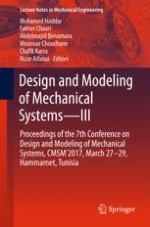This book offers a collection of original peer-reviewed contributions presented at the 7th International Congress on Design and Modeling of Mechanical Systems (CMSM’2017), held in Hammamet, Tunisia, from the 27th to the 29th of March 2017. It reports on both research findings, innovative industrial applications and case studies concerning mechanical systems and related to modeling and analysis of materials and structures, multiphysics methods, nonlinear dynamics, fluid structure interaction and vibroacoustics, design and manufacturing engineering. Continuing on the tradition of the previous editions, this proceedings offers a broad overview on the state-of-the art in the field and a useful resource for academic and industry specialists active in the field of design and modeling of mechanical systems. CMSM’2017 was jointly organized by two leading Tunisian research laboratories: the Mechanical, Modeling and Manufacturing Laboratory of the National Engineering School of Sfax and the Mechanical Engineering Laboratory of the National Engineering School of Monastir..
